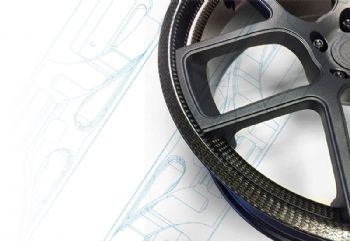
Wiltshire-based
www.carbonthreesixty.com Carbon ThreeSixty Ltd, an advanced composite structure specialist, is leading a new project co-funded by
Innovate UK, the UK’s innovation agency, to develop a revolutionary all-composite helicopter wheel.
The National Aerospace Technology Exploitation Programme (NATEP) project which began on 1 January and will run for the next eighteen months, is being delivered in partnership with the National Composites Centre, collaborating with Leonardo and ultimately aims to improve performance, safety and full ownership cost.
The aim is to leverage the consortium’s combined expertise to design, develop and manufacture an ultra-low mass, robust, proof-of-concept carbon fibre reinforced plastic (CFRP) wheel for rotary wing aircraft.
The current global market for helicopter wheels uses metallic light-alloy materials, usually aluminium or magnesium. These offer sufficient strength and stiffness from a relatively low density.
A wheel made of CFRP will offer significantly enhanced mechanical properties at approximately half the density of metallic wheels. Compared to aluminium alloys, a CFRP wheel will be lighter, with higher performance with an extended working life.
Existing light metal alloy helicopter wheels can suffer from undesirable fatigue failures and have to endure relatively harsh environments. This requires regular preventative and corrective maintenance throughout the life of the aircraft.
The fibrous microstructure and resin stability of advanced composites mean that fatigue life and corrosion resistance can be much improved when optimally designed. They also offer weight savings of around 30-40% over forged aluminium and improved NVH (noise, vibration and harshness) performance.
Weight reductions enable airframers to deliver efficiency, range and payload improvements and provide an option for lower power density propulsion systems, such as battery-electric. Composite wheels will also be interchangeable with existing wheels, making them suitable for retrofit applications.
Ed Allnutt, Managing Director of Carbon ThreeSixty said: “The application of advanced composite materials and processes specifically to aerospace wheels is a highly innovative step.
“Our experience with other composite wheel applications has shown that weight savings of 30 to 40% are achievable over forged aluminium solutions. We believe the key selling point, however, will be the improvements in fatigue life and failure mode which will extend life and improve safety.
The project will use cutting edge composite manufacturing technology such as tailored fibre placement (TFP), braiding and out of autoclave processes to ensure repeatability and scalability while utilising novel product and process design to enable the partners to protect IP required to successfully manufacture the products.
Alex Doyle, Technology Project Lead of National Composites Centre said: “Composite wheels have only become viable in the last 10 years due to improvements in resin system toughness, lower carbon fibre prices and improvements in process automation. We can see this in the automotive wheel market, where they are now proven.
“However, aerospace applications are more challenging. The shift in cost, combined with the technical improvements are the reason why now is the time composite wheels are feasible for aerospace rotorcraft applications.”
The scope of the project covers the specification, design, development, manufacture, inspection and testing of a proof of concept helicopter wheel, considering full aerospace requirements in line with the specification provided by Leonardo for an undisclosed platform.
Adrian Smith, R&T Portfolio Delivery at Leonardo Helicopters UK, said: “We are very keen to be involved in developing this technology. Composites are expected to save around 1.5kg over each 5kg alloy wheel. This 6kg weight saving overall represents almost 1,000 gallons of fuel saved over a typical 12,000hr service life and equates to around 12 tonnes of CO
2.”
The project is expected to last around 18 months, with a total budget of around £250,000. Deliverables will include 12 fully tested proof of concept wheels, and a methodology for design and manufacture.